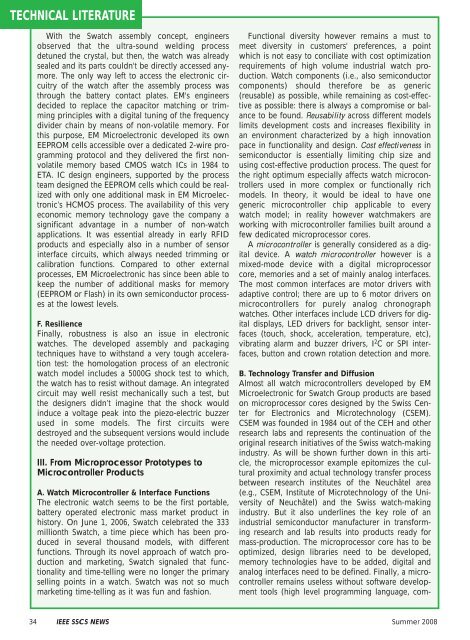Eric Vittoz - IEEE
Eric Vittoz - IEEE
Eric Vittoz - IEEE
You also want an ePaper? Increase the reach of your titles
YUMPU automatically turns print PDFs into web optimized ePapers that Google loves.
TECHNICAL LITERATURE<br />
With the Swatch assembly concept, engineers<br />
observed that the ultra-sound welding process<br />
detuned the crystal, but then, the watch was already<br />
sealed and its parts couldn't be directly accessed anymore.<br />
The only way left to access the electronic circuitry<br />
of the watch after the assembly process was<br />
through the battery contact plates. EM's engineers<br />
decided to replace the capacitor matching or trimming<br />
principles with a digital tuning of the frequency<br />
divider chain by means of non-volatile memory. For<br />
this purpose, EM Microelectronic developed its own<br />
EEPROM cells accessible over a dedicated 2-wire programming<br />
protocol and they delivered the first nonvolatile<br />
memory based CMOS watch ICs in 1984 to<br />
ETA. IC design engineers, supported by the process<br />
team designed the EEPROM cells which could be realized<br />
with only one additional mask in EM Microelectronic’s<br />
HCMOS process. The availability of this very<br />
economic memory technology gave the company a<br />
significant advantage in a number of non-watch<br />
applications. It was essential already in early RFID<br />
products and especially also in a number of sensor<br />
interface circuits, which always needed trimming or<br />
calibration functions. Compared to other external<br />
processes, EM Microelectronic has since been able to<br />
keep the number of additional masks for memory<br />
(EEPROM or Flash) in its own semiconductor processes<br />
at the lowest levels.<br />
F. Resilience<br />
Finally, robustness is also an issue in electronic<br />
watches. The developed assembly and packaging<br />
techniques have to withstand a very tough acceleration<br />
test: the homologation process of an electronic<br />
watch model includes a 5000G shock test to which,<br />
the watch has to resist without damage. An integrated<br />
circuit may well resist mechanically such a test, but<br />
the designers didn’t imagine that the shock would<br />
induce a voltage peak into the piezo-electric buzzer<br />
used in some models. The first circuits were<br />
destroyed and the subsequent versions would include<br />
the needed over-voltage protection.<br />
III. From Microprocessor Prototypes to<br />
Microcontroller Products<br />
A. Watch Microcontroller & Interface Functions<br />
The electronic watch seems to be the first portable,<br />
battery operated electronic mass market product in<br />
history. On June 1, 2006, Swatch celebrated the 333<br />
millionth Swatch, a time piece which has been produced<br />
in several thousand models, with different<br />
functions. Through its novel approach of watch production<br />
and marketing, Swatch signaled that functionality<br />
and time-telling were no longer the primary<br />
selling points in a watch. Swatch was not so much<br />
marketing time-telling as it was fun and fashion.<br />
Functional diversity however remains a must to<br />
meet diversity in customers' preferences, a point<br />
which is not easy to conciliate with cost optimization<br />
requirements of high volume industrial watch production.<br />
Watch components (i.e., also semiconductor<br />
components) should therefore be as generic<br />
(reusable) as possible, while remaining as cost-effective<br />
as possible: there is always a compromise or balance<br />
to be found. Reusability across different models<br />
limits development costs and increases flexibility in<br />
an environment characterized by a high innovation<br />
pace in functionality and design. Cost effectiveness in<br />
semiconductor is essentially limiting chip size and<br />
using cost-effective production process. The quest for<br />
the right optimum especially affects watch microcontrollers<br />
used in more complex or functionally rich<br />
models. In theory, it would be ideal to have one<br />
generic microcontroller chip applicable to every<br />
watch model; in reality however watchmakers are<br />
working with microcontroller families built around a<br />
few dedicated microprocessor cores.<br />
A microcontroller is generally considered as a digital<br />
device. A watch microcontroller however is a<br />
mixed-mode device with a digital microprocessor<br />
core, memories and a set of mainly analog interfaces.<br />
The most common interfaces are motor drivers with<br />
adaptive control; there are up to 6 motor drivers on<br />
microcontrollers for purely analog chronograph<br />
watches. Other interfaces include LCD drivers for digital<br />
displays, LED drivers for backlight, sensor interfaces<br />
(touch, shock, acceleration, temperature, etc),<br />
vibrating alarm and buzzer drivers, I 2 C or SPI interfaces,<br />
button and crown rotation detection and more.<br />
B. Technology Transfer and Diffusion<br />
Almost all watch microcontrollers developed by EM<br />
Microelectronic for Swatch Group products are based<br />
on microprocessor cores designed by the Swiss Center<br />
for Electronics and Microtechnology (CSEM).<br />
CSEM was founded in 1984 out of the CEH and other<br />
research labs and represents the continuation of the<br />
original research initiatives of the Swiss watch-making<br />
industry. As will be shown further down in this article,<br />
the microprocessor example epitomizes the cultural<br />
proximity and actual technology transfer process<br />
between research institutes of the Neuchâtel area<br />
(e.g., CSEM, Institute of Microtechnology of the University<br />
of Neuchâtel) and the Swiss watch-making<br />
industry. But it also underlines the key role of an<br />
industrial semiconductor manufacturer in transforming<br />
research and lab results into products ready for<br />
mass-production. The microprocessor core has to be<br />
optimized, design libraries need to be developed,<br />
memory technologies have to be added, digital and<br />
analog interfaces need to be defined. Finally, a microcontroller<br />
remains useless without software development<br />
tools (high level programming language, com-<br />
34 <strong>IEEE</strong> SSCS NEWS Summer 2008




